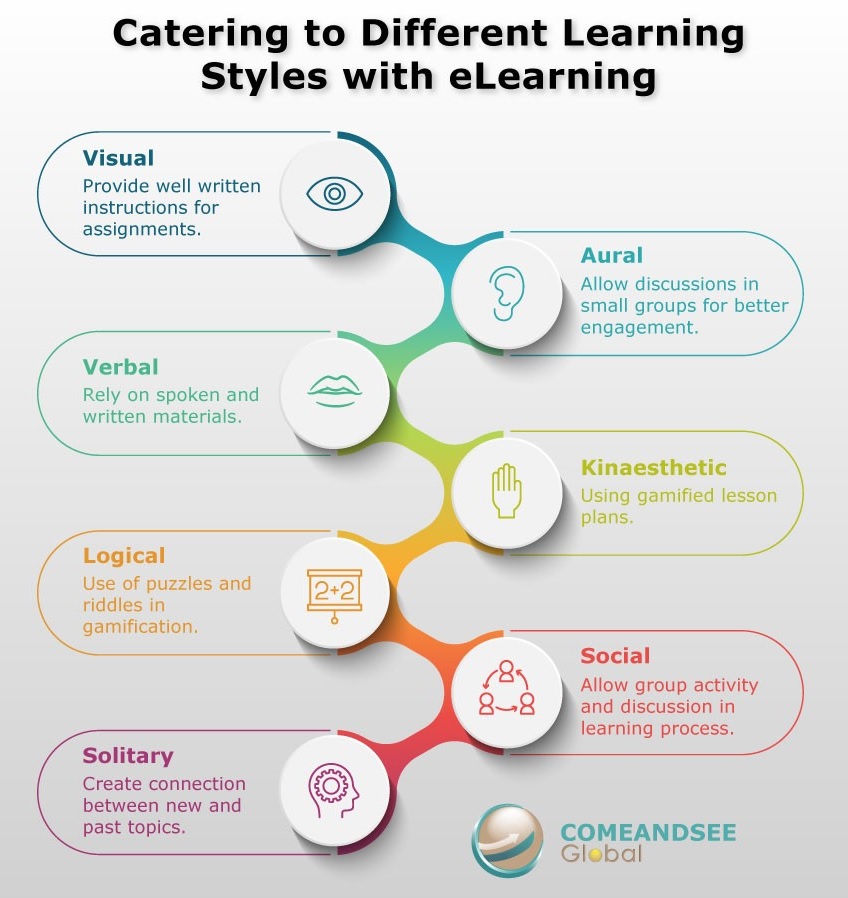Cater To Students' Individual Learning Styles: 3 Ways To Create Personalised Lesson Plans
12th April 2024

Teachers must identify and cater to each student's learning style in the different environments of ESL courses. Teachers may design interesting and successful lesson plans that meet the unique needs of each student by having a thorough awareness of their preferences. Read on to learn about a combination of ESL lesson plans, worksheets, and grammar exercises to illustrate how ESL teachers might adapt their lesson plans to accommodate various learning styles.
What Are The Various Learning Styles?

Source: www.linkedin.com
There are mainly 4 types of learning styles every ESL teacher must know about:
- Visual Learners
When trying to comprehend new material, visual learners respond well to the usage of maps, graphs, or visuals.
- Auditory Learners
Speaking and listening activities are the preferred method of comprehension and assimilation of new knowledge for auditory learners. This might be done by reading aloud or by holding lectures or conversations.
Hey, do you follow us on Social Media? We regularly share upgraded educational content, tips, feedback and more. Check us out by clicking the profiles here - Facebook / Twitter / LinkedIn / Pinterest / Instagram / YouTube
- Verbal Learners
Verbal learners are kids who learn better while they are reading or writing, such as when they are taking notes or reading from textbooks. These pupils are known as reading and writing learners. It could be simpler for those in this group to compose essays.
- Kinesthetic Learners
A hands-on approach to learning is preferred by kinesthetic learners. Conducting experiments in a scientific lab to determine how two components react with one another is an example of kinesthetic learning.
3 Ways To Cater To Students Through Customised Lesson Plans
You should work with your students to determine their preferred learning styles to help you organize courses efficiently and accommodate the many types of learners in your class.
Here are a few ways to create an individualized lesson plan for your students:
1. Understand The Various Learning Styles
Learning styles are essentially the many methods that people choose to learn, and there are many different ideas on this topic. While some individuals learn best by doing, others learn best by hearing about it, and still others must observe. While this is significant in and of itself, it indicates that if you concentrate solely on one style, a portion of your class will find it difficult to understand.
Therefore, the visual and kinaesthetic learners would be left out if you only teach your class. For this reason, you should include in your ESL classroom as many games, activities, and media that cater to a variety of learning styles. You'll be able to become the greatest ESL instructor possible if you do this.
2. Integrate Learning Styles In Lesson Plans
Flexibility is essential while writing ESL lesson plans. For those who learn best visually, include visual components in your lesson plans, such as infographics, films, and flashcards. To explain vocabulary terms or grammatical principles, use visual aids.
To engage auditory learners, use music, podcasts, and listening activities. To improve speaking and listening abilities, promote debates, role-plays, and conversations. For kinesthetic learners, incorporate games, crafts, and hands-on activities that require movement and tactile sensations. Reinforce verbal principles with body language and gestures.
3. Use Grammar Exercises And ESL Worksheets
Grammar drills and ESL worksheets are useful resources for accommodating various learning preferences. Make visually engaging worksheets available, such as these vocabulary puzzles using charts, graphs, and drawings to convey knowledge. To draw attention to important elements, highlight or apply color coding.
For students who learn best with audio input, incorporate listening comprehension activities into worksheets. For kinaesthetic learners, make interactive worksheets with practical exercises like role-plays, matching games, and even physical movement for grammar drills. This book of speaking and listening activities has many ideas.
What Are The Benefits Of Understanding Learning Styles
Some of the benefits of understanding how students learn include:
- Reduces potential stress or frustration about taking on new information
- Allows learners to identify their strengths and work on it
- Helps learners develop skills to use in later life
- Increases self-confidence of the students
- Promotes the social aspect of students in school
- Encourages learners to be curious problem solvers
- Prevents students from being disengaged fosters disruptive behavior
Help Your Students Achieve Their Learning Goals
Teaching professionals with a 120-hour international TEFL Certification Course may develop inclusive and productive lesson plans by recognizing and addressing the variety of learning styles seen in ESL classes. Better language learning results are promoted and student engagement is increased when visual, auditory, and kinesthetic components are incorporated into ESL lesson plans, worksheets, and grammar exercises.
We believe education should be accessible for everyone. That’s why we don’t charge for our blogs. Find the right course that will help you in your career with us, contact us at - 1800–212–6400. You can mail us at act@asiancollegeofteachers.com.